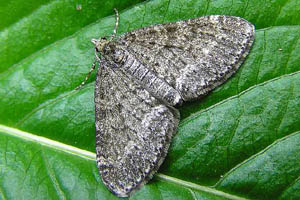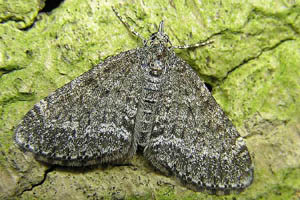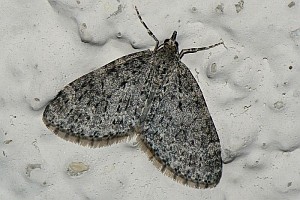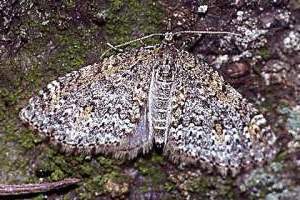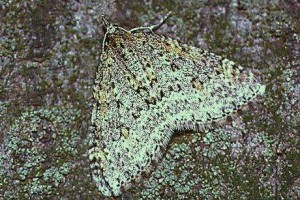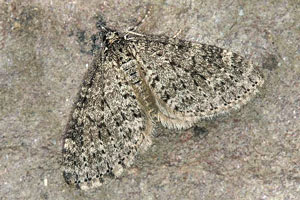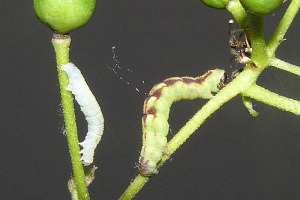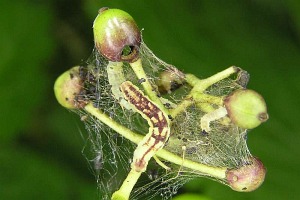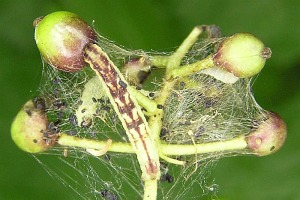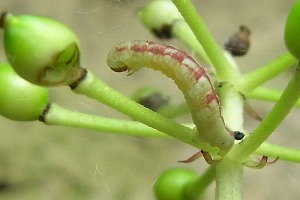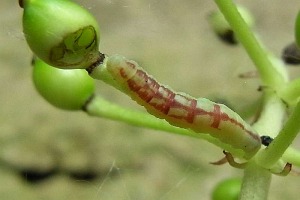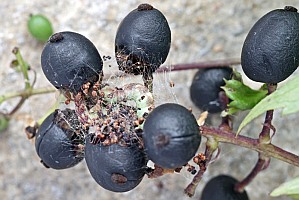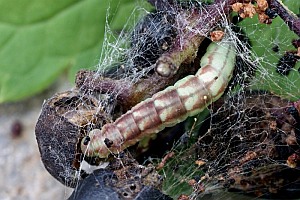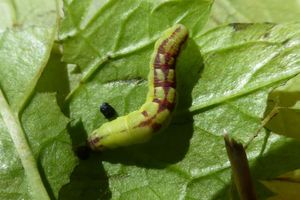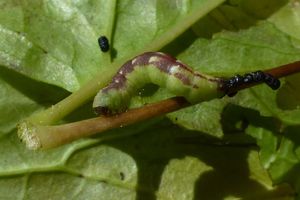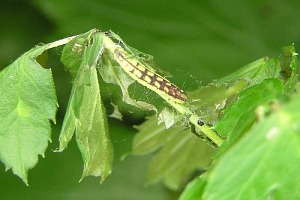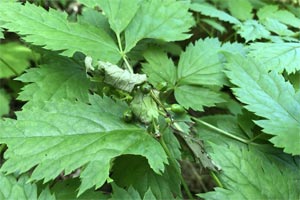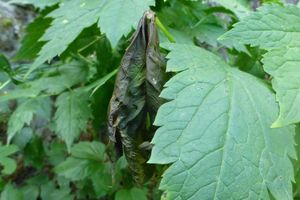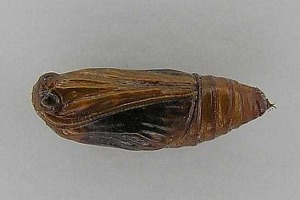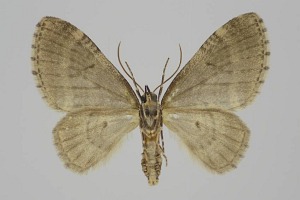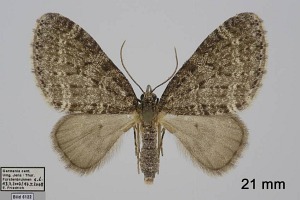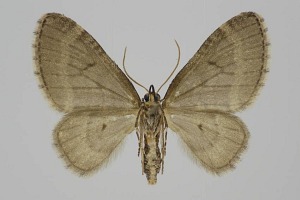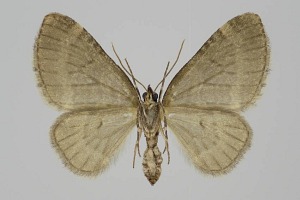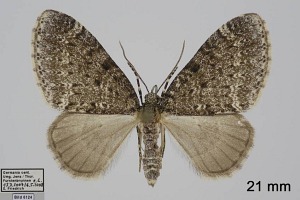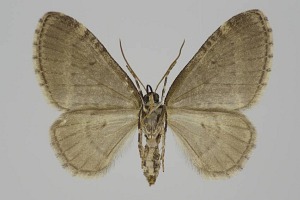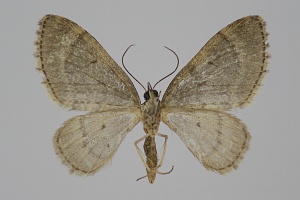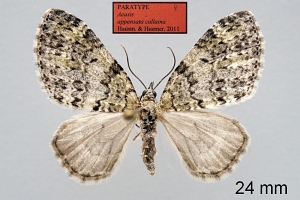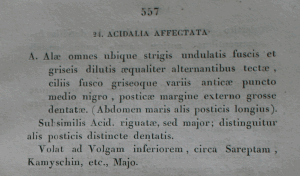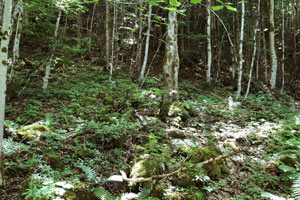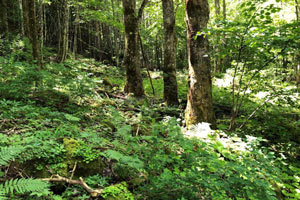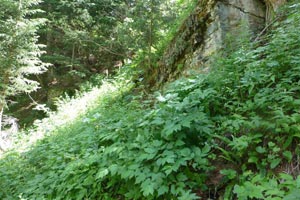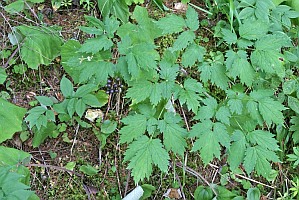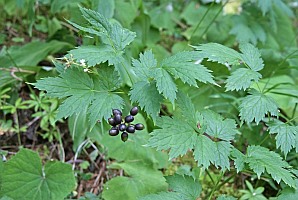

 +22Kontinente:EUAS
+22Kontinente:EUAS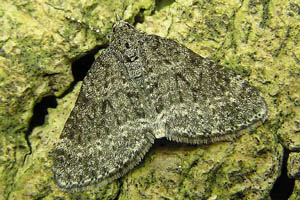
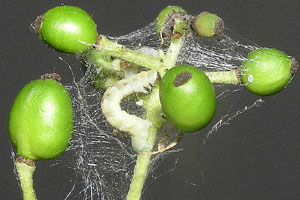
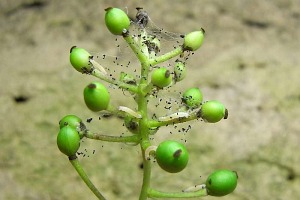
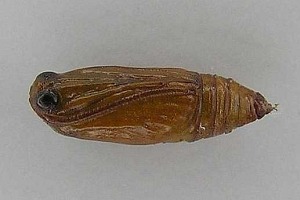
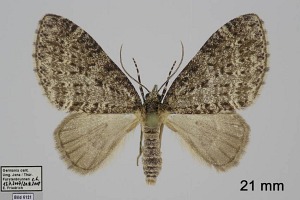
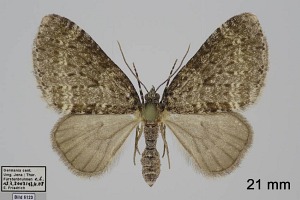
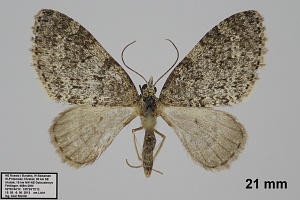
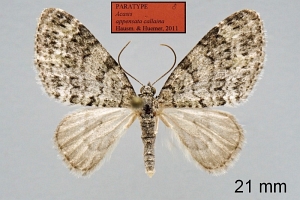
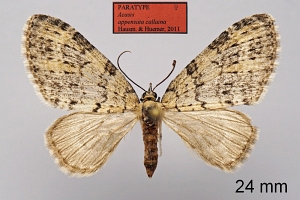
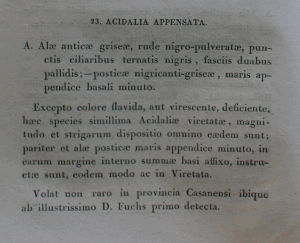
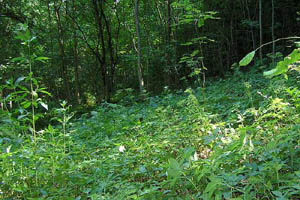
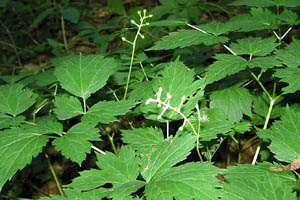
1. Lebendfotos
1.1. Falter
1.2. Raupe
1.3. Fraßspuren und Befallsbild
1.4. Puppe
2. Diagnose
2.1. Männchen
2.2. Weibchen
2.3. Ssp. baikalensis
2.3.1. Männchen
2.4. Ssp. callaina
2.4.1. Männchen
2.4.2. Weibchen
2.5. Erstbeschreibung
3. Biologie
3.1. Habitat
In den Kalkbuchenwäldern um Jena leben an verschiedenen Stellen gleich drei Geometriden, die an Actaea spicata gebunden sind, zusammen im selben Lebensraum: Eupithecia actaeata, Eupithecia immundata und Acasis appensata. (Text: Friedrich Egbert)
3.2. Raupennahrungspflanzen
3.3. Nahrung der Raupe
- [Ranunculaceae:] Actaea spicata (Ähriges Christophskraut)
- [Ranunculaceae:] Actaea erythrocarpa (Sibirisches Christophskraut)
- [Caprifoliaceae:] Valeriana sambucifolia (Holunderblättriger Baldrian)
- [Plantaginaceae:] Veronica longifolia (Langblättriger Ehrenpreis)
In Mittel- und Südosteuropa scheint diese Art ganz und gar an Actaea spicata als Eiablage- und Raupennahrungspflanze gebunden zu sein, wobei sich die Raupe ganz überwiegend von den heranreifenden Früchten ernährt, teilweise auch von angewelkten Blättern. Dies ist durch viele Dutrzend Beobachtungen in ganz unterschiedlichen Regionen gut belegt und wird insbesondere durch Burmann (1955) und Schütze (1956) ausführlich besprochen.
In Nordeuropa wurden Raupen entsprechend an Actaea erythrocarpa gefunden (z.B. Mutanen et al. (2003)).
Doch die Art kommt in Nordeuropa auch in Küstenhabitaten vor, wo diese Pflanzen fehlen. Nach Mutanen et al. (2003) wurden in Schweden schon Weibchen bei der Eiablage an Veronica longifolia beobachtet und die Raupen mit dieser Pflanze auch gezüchtet - doch in den finnischen Küstenhabitaten mit Vorkommen des Falters fehlt auch diese Pflanze meist - und dort woe sie vorkommt, wird sie nicht genutzt. Die Verfolgung eierlegender Weibchen folgte auch dort zum Ziel - sie erfolgte in Blütenstände von Valeriana sambucifolia: "In 2002, we followed ovipositing females in a known seashore occurrance site in Oulunsalo, and saw them to lay eggs on Valeriana sambucifolia. Later in the season, hundreds of eggs and larvae were found on this plant, while the larvae feed in a silken tube on flowers and seeds. Since no larvae were found on V. longifolia, we consider V. sambucifolia its primary host in coastal areas, whereas most records from Finnish Lapland can be best associated with V. longifolia. A. appensata is therefore known to feed on three, distantly related plant species. Possibly those plants share an unknown chemical necessary for larval growth and recognized by ovipositing female. It is also possible, that the forms belong to biologically distinct species. Further studies are needed to answer this question."
(Autor: Erwin Rennwald)
3.4. Lebensweise
Zum Nachweis der Art ist die Suche nach Eiern oder Raupen weitaus erfolgversprechender, als am Licht auf den flugfaulen Falter zu hoffen. Die Falter fliegen üblicherweise im Juni und legen ihre Eier meist an die unreifen (grünen) Actaea spicata-Früchte. Ab Anfang Juli sind dann die ersten Jungraupen zu finden, welche zunächst gesellig in Gespinsten im unreifen Fruchtstand sitzen und dort die Früchte befressen. Dieses Befallsbild ist im Gelände gut auffindbar. Siehe Bild oben.
Da bei zu hohem Raupenbesatz die Früchte einer Pflanze oft vollständig ausgehöhlt sind, weichen die extrem bewegungsfaulen Raupen manchmal auch auf Blätter derselben Pflanze aus. Und dies, obwohl in weniger als 1 m Abstand noch unbesetzte Pflanzen mit frischen Früchten stehen.
(Autor: Egbert Friedrich)
4. Weitere Informationen
4.1. Etymologie (Namenserklärung)
„appendeo hänge an, nach dem Lappen der männlichen Hinterflügel.“
4.2. Andere Kombinationen
- Acidalia appensata Eversmann, 1842 [Originalkombination]
4.3. Unterarten
- Acasis appensata baicalensis (Bang-Haas, 1906)
- Acasis appensata callaina Hausmann & Huemer, 2011
4.4. Faunistik
Hausmann & Viidalepp (2012: 518-519) zeigen eine Karte mit stark zersplittertem Areal in Nord- und Nordosteuropa und davon weit getrenntem und noch stärker zersplittertem Areal imsüdlichen und südöstlichen Mitteleuropaübr das Balkan bis hin in den Nordwesten der Türkei (1 Punkt bei Bolu). In Italien gibt es ein völlig isoliertes Vorkommen in den Appenninen (ssp. callaina).
Plant et al. (2021) melden die Art als neu für Serbien und kommentieren: "South-eastern Europe shows only three map dots in this work for Acasis appensata – two in Bulgaria and one in the southwest of Romania (Hausmann & Viidalepp, 2012). The species was reported as a new species for the Balkan Peninsula from Bulgaria, on the Rila Mts. above Kostenets Village, 03.05.1912, a single male, leg. I. Buresch in coll. NMNHS (Fig. 2D); genitalia prep. 01./21.01.2021, S. Beshkov (Fig. 3D) vide Buresch, 1914). Later, Slivov & Lukov (1976) recorded a single female from the slopes of Mt Vitosha near Boyana village on the outskirts of Sofia, at 800 m a.s.l., 10.08.1962. Both records are listed by Nestorova (1998), who makes no further additions. It should be noted that we have not seen the specimens from Vitosha; whilst not doubting the data, it seems rather unlikely that the genitalia were checked, since Lukov (a Noctuidae specialist) did not undertake any genitalia work and only illustrated a handful of species. Accordingly, judgement is reserved. A third report for Bulgaria is that of Beshkov (2011), who lists the species from two close, but separate, localities above Petrich town in Platanus/Castanea/Corylus forest on the Belasitsa Mts. as follows: 2 ♂♂, Above Petrich, on the Louda Mara River between Gorski Kat and Vodohvashtaneto, 41°22'03" N, 23°12'30" E, 174 m a.s.l., 29.05.2010, leg. S. Beshkov, in coll. S. Beshkov and, 1 ♂, Above Petrich on the Louda Mara River, 41°22'21" N, 23°12'24" E, 470 m a.s.l., 29.05.2010, leg. S. Beshkov, in coll. S. Beshkov."
Weiter heißt es bei Plant et al. (2021: 35-36): "The remaining southeastern Europe map dot, in the southwest of Romania, cannot be resolved in terms of the country of origin without further investigation since it is placed on the boundary between Romania, Bulgaria and Serbia. Investigation proves that this record is also mapped by Székely (2010); it relates to the report from the Retezat Mts. (1000-1300 m a.s.l.) in southwest Romania of six specimens in the Diószeghy 36 P. COLIN et al. collection: 17.05.1922, 26.05.1922, 27.05.1922 (2) and 04.06.1923 (2), published in the Diószeghy collection catalogue (Căpușe & Kovács, 1987). Other records for A. appensata in Romania are all from the north (e.g., Bicaz Gorges (eastern Carpathians) and the Noroieni Forest (northwestern Romania) and are omitted from this present analysis of the Balkan Peninsula. Acasis appensata is known also from Croatia, but only in the northwest Illyria/Adriatic area (Stauder, 1929) and it may not have been seen in that country since then (Toni Koren, personal communication). Dr Koren also advises that his database indicates a complete absence of reports of A. appensata from Bosnia and Herzegovina. We are unaware of any reports of A. appensata from North Macedonia or Albania, or from European Turkey, although there is a single report from Asiatic Turkey, some distance east of the Bosporus – a surprising locality. Given that Mt. Belasitsa, a known locality for the moth in Bulgaria, lies on the border of Bulgaria, North Macedonia and Greece, the presence of A. appensata in the latter two countries seems highly likely."
Bei der Suche nach neuen Fundstellen für Acasis appensata sollte man wohl Botaniker nach Vorkommen von Actaea spicata fragen.
(Autor: Erwin Rennwald)
4.5. Literatur
- Burmann, K. (1955): Ein kleiner Beitrag zur Kenntnis der Lebensweise der Raupen von Acasis (Lobophora) appensata Ev. (Lepidoptera. Geometridae). — Nachrichtenblatt der Bayerischen Entomologen, 4: 23-26. [PDF auf zobodat.at]
- Erstbeschreibung: Eversmann, E. (1842): Quædam lepidopterorum species novæ, in Rossia orientali observatæ, nunc descriptæ et depictæ. — Bulletin de la Société Impériale des Naturalistes de Moscou 15 (3): 543-564, pl. V-VI.
- Erstbeschreibung der ssp. callaina: Hausmann, A. & P. Huemer (2011): Taxonomic decision as a compromise: Acasis appensata (Eversmann, 1832) in Central Italy—a case of conflicting evidence between DNA barcode and morphology (Lepidoptera: Geometridae). — Zootaxa 3070: 60-68. [PDF (open access) auf mapress.com]
- Mutanen, M., Välimäki, P. & H. Pöykkö (2003): Pohjanliuskamittarin (Acasis appensata) merenrantamuodon ravintokasvi ja biologia. The food plant and biology of the coastal form of Acasis appensata. — Baptria, 28 (3): 18-22. [PDF (ganzes Heft) auf perhostutkijainseura.fi]
- Plant, C., Beshkov, S., Jakšić, P., King, A., & A. Nahirnić (2021): First report of Acasis appensata (Eversmann, 1842) in Serbia with an examination of the genus Acasis Duponchel, 1845 (Lepidoptera: Geometridae) on the Balkan peninsula. — Acta Entomologica Serbica, 26 (1): 31-40. https://doi.org/10.5281/zenodo.5008943. [PDF auf aes.bio.bg.ac.rs] bzw. [PDF auf researchgate.net]
- Schütze, E. (1956): Über die Lebensweise der Raupe von Acasis (=Lobopbora) appensata Ev. (Lep. Geometr.) II. Mitteilung. — Nachrichtenblatt der Bayerischen Entomologen, 5 (10): 97-100. [PDF auf zobodat.at]






















